|
Troy Bayliss is having a great time with the new Ducati Testastretta technology; the
Superbike World Championship first year out, and this is written eleven wins out of a possible 14 in 2002; cool.
The engine known as the Desmoquattro is nearly 15 years old, not bad in these days of
constant change and redesign; of course the last versions of the motor represent one of the most highly developed performance engines in current production, certainly engines capable of winning world class races.
But we cannot hide the engines age from the legislators, new emissions laws requiring better combustion and greater long term reliability are coming into being.
In power terms too the Ducati Corse and the Road bike development crews have done a brilliant job of taking the motor to the max; but now something more is needed; you cannot allow an opponent like Honda to start with a clean sheet of paper and not have to up your own game to remain competitive.
In late 2000 the 996R was launched; 350 bikes sold to the world on the internet.
The bike was a development of the classic 996 shape with the new development street engine in it. Sand cast crankcases with a deep sump, new out put shaft bearings and wonder of wonders a new short stroke crank with bigger lighter pistons and, at last, a brand new head design. The 996R pistons are 30 grams lighter than the 996SPS ones they replace; they travel through a shorter stroke and are now capped by a cylinder head with valves spaced to fit over the new 100mm bore.
The inlet valves on the street engine are now a massive 40mm (up from 36mm) and are at an
included angle of only 25 degrees. This impressive sounding spec also got a revised (but still Desmodromic) valve actuation system. Have a look at Doug Lofgrens article on these heads if
you want a bit more insight on that aspect.
No one has really done much work on these street engines as all the effort is going into the more
extreme RS variant. Sigma however specialises in getting the best from the street stuff, so a 996R or the later more mass produced 998s, (the 2002 998S engine has the same deep sump
sand cast crankcases (made in super tough Galsi 7 alloy) as the homologation engines but with the mass production side of the motor just a little more finished) was going to be in our future.
We couldn't wait to get our hands on one of these motors; we knew what we wanted to do to it,
but finding one in time to really enjoy the learning curve was fun. We did it though thanks to Rupert Murdon, he wanted to race Endurance, British or World in the Superstock category and he
wanted a bike for the TT too.
Now its important to understand what the brief was here. Superstock is a stock racing class, the
rule book is full of things you cannot do; very restrictive, indeed just like the brief we would get from a customer who just wanted his bike as good as it could be without lots of racing only parts.
As this is the core of our business; 'the Full Monty' semi blueprint and service this suited us very well. We get to prove what good assembly can do and then race it too……
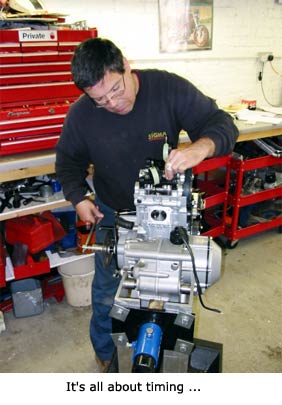 So we set to work, the engine was completely stripped and cleaned, clearances were measured and reset where allowed
and necessary. No stone as they say was left unturned. The motor is well built, only time will tell if it is tougher, but the strength of the crankcases, pistons 30 grams lighter
than stock, shorter oil lines to the heads and a different rocker layout all auger well. So we set to work, the engine was completely stripped and cleaned, clearances were measured and reset where allowed
and necessary. No stone as they say was left unturned. The motor is well built, only time will tell if it is tougher, but the strength of the crankcases, pistons 30 grams lighter
than stock, shorter oil lines to the heads and a different rocker layout all auger well.
A brief discourse on exhaust sizes in needed here, so….Big cylinders produce their power
in big chunks, a 998 V-twin racer operating near its peak sends out 12000 499cc chunks of expanding gas every minute; or about 200 chunks per second, the mufflers have to
be capable of dealing with chunks of gas this size arriving this quick. A 750 four by comparison, near its power peak of 14500rpm is throwing out 240 187cc chunks. By comparison that is a doddle……
It is not in itself difficult to keep an engine
quiet; it is however very difficult to keep an engine quiet and allow it to keep both its power and powerband width (see Supermono Tech2) for a previous story on
this front). To give us some basis for comparison lets express these 'amounts of exhaust gas per second in terms of 'litres per sec'; so the 12000 rpm 998 is shifting near as dammit 100 liters per sec (LPSec);
the 750 four is on about 90 LPSec (which if you think about it also says why V Twins win under the current rules!!); you'll see why later…..
The noise limits in FIM Superbike, Supersport and Superstock competitions were reduced five
years ago from 105Db to 102Db, the Carbon or Titanium sleeved 'slip-ons' currently sold for 'performance use' Ducati's typically are of the old 105Db design ; in club racing and sporting use
the difference between 105 and 102 Db is not really an issue, on the track however the ability to keep the engine under 102Db and keep or improve the peak power number and keep or improve
the power band width is all important.
Big twins (and, from my previous life, singles) are therefore up against it from the start; for this
reason a new family of pipes arrived. Built in thin wall stainless steel at the front and with Titanium pipes and sleeves at the rear these pipes had larger pipes sizes and courtesy of some
careful tuning of the tapers inside the muffler sections kept the noise down to 102Db and kept both the power and the engines ability to hang on to the power at high revs (remember, these
pipe sizes are not designed to let you smoothly carburet as you trickle between the cars in traffic jams). The 54mm 'tapered muffler' system that came with all the 748RS bikes is also the pipe of
choice for the 996S and SPS engines (the reason is that the 748 revs to a power peak of about 12000 rpm so it's a 75 LPSec motor and the 996S, with 10k rpm being 'enough' is pretty similar at 83 LPSec.
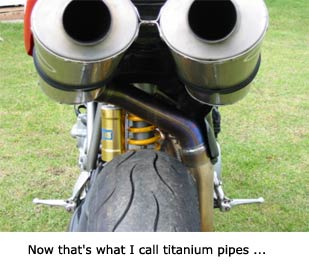
On the 996 and 998 RS and Factory bikes however pipe diameters have
had to keep rising to cope with the higher revs (and therefore the larger amount of gas being slung about) the 996Rs in 2000 had a 57mm system and the 2002 999cc (998R)works bikes are now up to 62.5mm to cope with
13500 rpm running and 115 LPSec………
Superstock allows different exhaust systems so after consulting various
friends in the Ducati empire our first shot was for a full works 57mm Termignoni system - the same mufflers that came on the full racing 996RS (97ish LPSec) of 2000. Just fitting the system caused us fits, the
right hand side foot rest needed to come out 15mm just to go round the pipe; the standard undertray had to be swapped for a carbon item as there was simply no room for the plastic piece.
Our plan was to make the motor as accurate as we could reasonably do then allow the engine to
rev; this is a strategy that is going to shorten the life of various components (Rods and pistons) but the gamble is that we can gain peak power on our 2001 SPS racebike but by freeing up some
revs, and with all our care and attention allowing the bike to breathe at the higher RPM we would gain a wider power band. Now lets calculate that pipe again; 11250 rpm and 998cc gets us a 93
.75 LPSec engine, so if the build and the pipes let it rev reliably we can gear it down; and therefore spread the benefit of that increase in power band width all the way through the rev range.
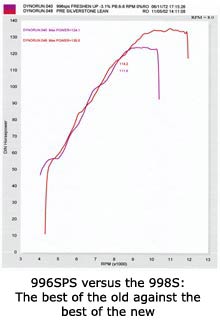
And gearing down is where the power is really released; have a look at the dyno charts here (click to enlarge).
Our 998S Superstocker up against our best ever run
on the 2001 996SPS Endurance engine; you can clearly see the benefits of the new head, This is the base curve; you can clearly see the way the 998S Superstocker (all standard parts plus the pipes
remember; just well assembled) revs on.
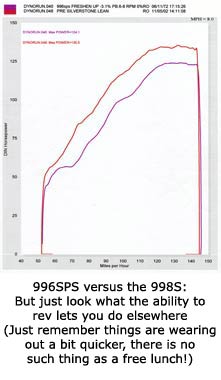
Now lets let the gearing do the talking. This graph shows two 4th gear roll ons on our local friendly
Dynojet. With the revised gearing allowing the Testatrettas high speed breathing to come forward you can see the effect this has on the power the riders have to use. At 75mph in 4th there is nearly 25 bhp
more than last year, thats 40% more power at a typical corner exit speed; just think how that translates into acceleration down the straight!
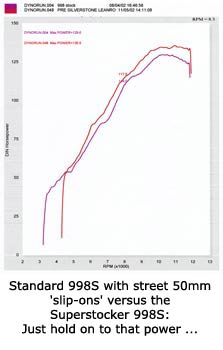
Again for perspective here is a stock 998S with
standard 'road type' 50mm slip-ons and a Ducati Performance fuel map extended to 11600 RPM, you can clearly see the power dropping off at peak and the lower output throughout the range the normal map
stops at 10400 rpm so the difference in performance is going to be clearly noticeable.
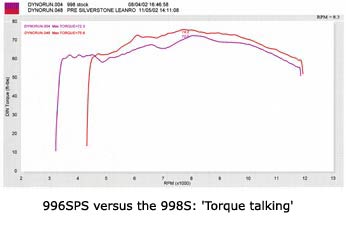
Just to finish things off here are the Torque curve comparisons; nice open smooth torque, no sudden changes to upset the tyre
grip or the bike ability to get the power down, just magic, in that lovely Ducati way….
Too see how we got on with the 998S Testastretta on track, have a look at Racing 2002.
The new bits in the Motor……………
We thought you would like to see some of the more interesting differences between the old and
new engines………
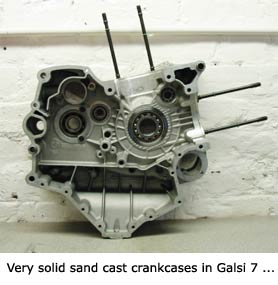
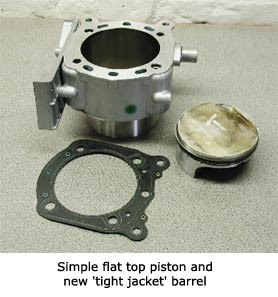
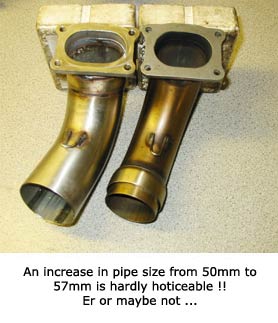
|
© Neil Spalding 2002. All rights reserved
|
|